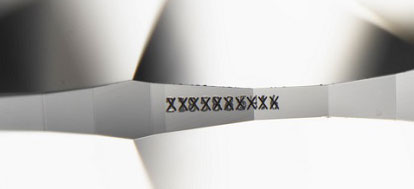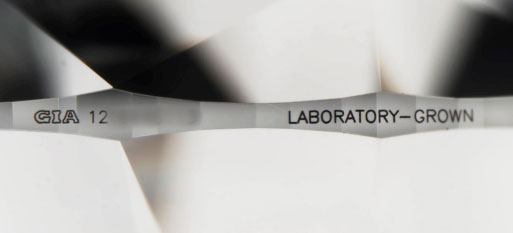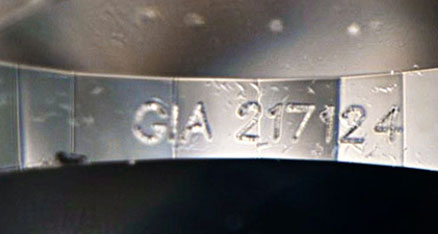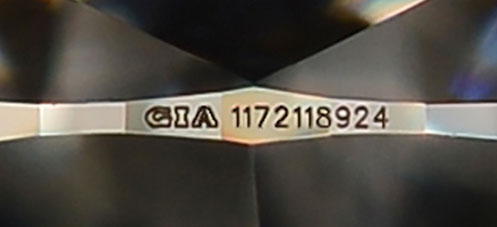Hot off the press: Imposter diamonds & forged inscriptions
When GIA’s grading lab examines a diamond, the lab produces a report for the client and inscribes the diamond with the lab report’s number. The idea is that the inscription identifies the exact stone described in the report.
Now, beware a new fraud: forged inscriptions.
The picture shows what GIA does when it encounters a forged gem inscription.
Just what is a forged inscription? In this scam, the number of a previous GIA diamond report is inscribed on a stone of lesser quality—an imposture, posing as a diamond of value.
The imposter stone might be a lab-made diamond with the report number of a mined diamond. It might be a treated diamond with the report number for an untreated stone. In one case the pretender was even a diamond simulant, Moissanite, carrying the report number of a mined diamond.
Now, it’s not unusual for GIA to receive lab-made diamonds, treated diamonds, and even simulants for grading. Some may be sent in by a producer, to test whether GIA can recognize the product. But these recent stones are the first to bear inscriptions purportedly by GIA.
When GIA receives such falsely inscribed diamonds, it obscures the fraudulent inscription (see picture at top) and issues a new report for the stone. For lab-made stones, it also inscribes LABORATORY-GROWN on the girdle of the stone.
The imposter stones GIA examined were close (though not exactly the same) in weight, color grade and clarity grade to the diamonds they imitated. If undetected, a falsely inscribed gem could be valued much higher than it merited.
And if the imposter were insured at that higher value, might it be a candidate for a convenient loss?
How widespread is this fraud?
In past issues we’ve discussed counterfeit GIA reports. Forged GIA inscriptions are a step up from that.
GIA is the name central to such frauds because GIA is so respected worldwide. GIA’s grading standards are widely accepted and its inscription is not likely to be questioned. With a counterfeit report, or even just the report number, one can easily go online and verify the quality of the stone. But that lookup number and report would verify the stone GIA actually examined, not the stone falsely inscribed!
Ideally, selling jewelers examine and validate the quality of all the jewelry they sell. However, many jewelry retailers have neither the training nor the gemological lab to perform a proper inspection. In one insurance survey, 78% of insurance appraisals were written by jewelers with no gemological training. Such jewelers often rely on whatever documentation and assurances come with the jewelry.
And all too often appraisers simply use information from the GIA report, rather than verifying the stone by independent examination.
Consumers, too, may just accept the lab report offered, along with verbal praise for GIA and the benefit of a GIA inscription. They trust the jeweler’s word, the documentation, and the good price they got.
This scam is a multiple fraud.
- It takes advantage of GIA’s reputation.
- The GIA name puts everyone (retailer, purchaser, insurer) at ease. Buyers are less motivated to seek an independent appraisal and underwriters are less likely to insist on one.
- Lower-value stones are passed off as valuable diamonds.
What’s an insurer to do?
This situation highlights the importance of a good appraisal — from a reliable appraiser, independent of the seller, who actually examines the stone and verifies all information.
An appraiser will likely ask if there is a lab report. Untrained/unethical appraisers may just copy data from the lab report into the appraisal. Poor appraisers, if they notice discrepancies between what the lab report says and what their own exam shows, may decide to just trust GIA over their own judgment. In effect, copying info from the lab report.
Reliable, trained appraisers, such as GG and FGA+ appraisers, will hopefully rely on their own expertise and trust their judgment. They should also be aware of current scams like forged inscriptions and lab reports and be on the lookout. And they’ll recognize—as GIA has pointed out in reporting on this fraud—that the font used for the fraudulent inscriptions is not at all like GIA’s.
FOR AGENTS & UNDERWRITERS
All diamonds of one carat or more should have a report from a nationally respected independent lab. Labs can afford the instruments needed to distinguish mined diamonds from their less-valuable counterparts that are lab-grown, and they have gemologists with the expertise to recognize gem treatments. We recommend the following labs and suggest that you use these links to verify reports you receive.
GIA Report Check
AGS Report Verification
GCAL Certificate
A lab report is not a substitute for an appraisal, since it describes only the gem, not the setting, and it does not give valuation.
The best appraisal includes the JISO 78/79 appraisal form and is written by a qualified gemologist (GG, FGA+, or equivalent), preferably one who has additional insurance appraisal training. One course offering such additional training is the Certified Insurance Appraiser™ (CIA) course of the Jewelry Insurance Appraisal Institute.
The counterfeit GIA certificates were used HEAVILY to support Internet sales. This may also prove to be true for diamonds fraudulently inscribed. If you know the diamond was purchased over the Internet, be especially wary.
FOR ADJUSTERS
Base the settlement on descriptive information from the appraisal and lab report, not on the valuation.
On a damage claim, ALWAYS have the jewelry examined in a gem lab that has reasonable equipment for the job and is operated by a trained gemologist (GG, FGA+ or equivalent), preferably one who has additional insurance appraisal training, such as a Certified Insurance Appraiser™.
If it’s not a total loss, it can be useful to have a qualified appraiser examine the remaining jewelry to verify the accuracy of the appraisal used to obtain insurance.
©2000-2025, JCRS Inland Marine Solutions, Inc. All Rights Reserved. www.jcrs.com





